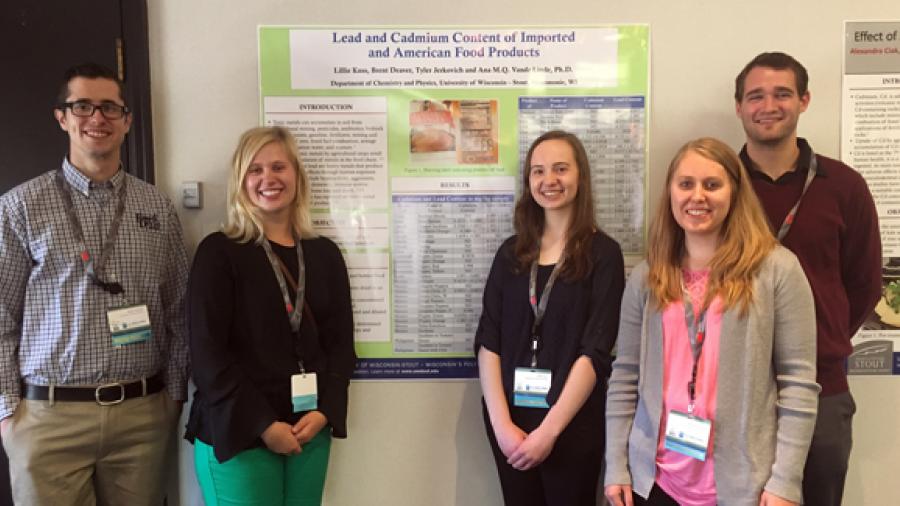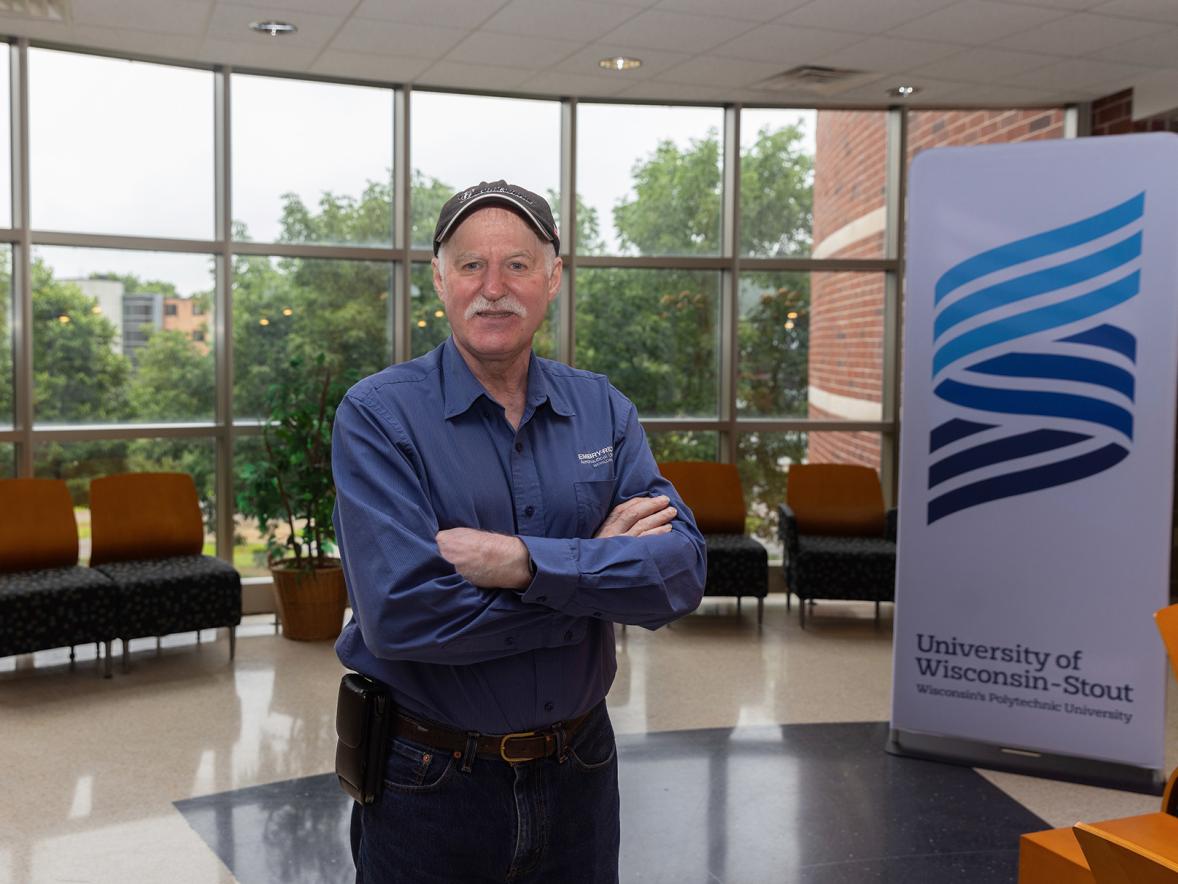
A group of University of Wisconsin-Stout students recently showcased their nearly yearlong research projects, which uncovered valuable information for consumers about toxic metals in common foods.
Five of seven students who conducted the research presented their studies in Minneapolis at the U.S. Food and Drug Administration Regional Food Safety Seminar and the National Environmental Health Region 4 Conference, hosted by the Minnesota Environmental Health Association.
The first of two projects was titled “Lead and Cadmium Content of Imported and American Food Products.” The second project was the “Effect of Zinc Application on Cadmium Absorption in Kale and Snow Peas.” The following students worked on one or both projects:
• Brent Deaver, of Viroqua, recent graduate, majoring in environmental science (projects 1 and 2)
• Lillie Kuss, of Cold Spring, Minn., junior, food science (projects 1 and 2)
• Alexandra Ciak, of New Richmond, senior, environmental science (project 2)
• Tyler Jerkovich, of Hibbing, Minn., senior, environmental science (project 1)
• Lilia Theisen, of Forest Lake, Minn., junior, environmental science (project 2)
• Christina Hang, of Eau Claire, sophomore, applied science (project 2)
• MaiHer Xiong, of Walnut Grove, Minn., junior, environmental science (project 2)
The groups conducted their studies in the research lab of Ana M.Q. Vande Linde, professor and chair of the chemistry and physics department.
After months of research, the findings were presented as posters to public health and environmental health professionals from across Minnesota, Iowa, Nebraska, South Dakota and North Dakota. The students from UW-Stout were the only undergraduate presenters.
One group of students set out to find the amounts of cadmium and lead in imported and domestic food products. The students collected their samples from local grocery stores. Imported food samples originated from various countries, including Guatemala, Philippines, Mexico and Korea. Cabbage, cauliflower, celery, lettuce, mushrooms, potatoes, numerous kinds of beans and rice and canned products including sardines, chili peppers, water chestnuts and oysters were some of the products analyzed. The project ran from fall 2016 to summer of 2017.
Kuss explained the process of determining the toxic metal content involved in drying the food samples, digesting in concentrated acid and determining the toxic metal content using the atomic absorption spectrometer.

“We did find lead in a lot of food products. Very small amounts, but there was definitely lead in almost every sample,” said Deaver. A majority of the food samples contained either lead, cadmium or both.
One of the group's surprising findings was the label from a can of mandarin oranges. It had a warning label that said, “This product contains lead, a chemical known to the state of California to cause birth defects or other reproductive harm.” Kuss said she was surprised that the can “was the only one with the warning label.”
Vande Linde said that both lead and cadmium can be absorbed by plants from the soil. Accumulation of lead in the soil comes from mining operations, gasoline, pipes and solder. Cadmium is present in the soil from mining and from phosphorus-containing fertilizers. Traces of lead and cadmium can be transferred from food containers glazed with these metals.
Exposure to lead can cause profound adverse health effects, especially for young children. Chronic intake of cadmium has been linked to kidney failure and severe osteoporosis.
Minimizing absorption of cadmium by plants
“We tried to find out if there is a way to minimize the absorption of cadmium by plants,” Vande Linde said.
The objectives of the second project were to determine the effect of zinc on the absorption of cadmium and to find differences in cadmium absorption by plants treated with zinc in the soil and by foliar spray. The group tested snow peas and kale plants.
The students grew the plants from seeds, waiting two weeks or until the plants started to germinate before starting the treatments. A solution containing cadmium ions was added into the soil. A solution containing zinc ions also was applied to the soil in one treatment group and on the leaves of the plants — the other treatment group — three times a week for eight weeks.
There were nine pots per types of plant, each pot contained five plants — three pots served as control group and six pots for the two treatment groups. The project lasted from November 2016 to August 2017. After eight weeks, the plants were harvested, cleaned and the shoots, roots and beans were processed to determine the cadmium content.
“We thought there was going to be a significant difference in the cadmium content of the shoots, roots and beans in the control versus the two treatment groups,” Ciak said. “We observed a decrease in the amount of cadmium absorbed by the treatment groups. However, it was not statistically significant.”
The zinc project was only done in three trials. Vande Linde is looking to recruit more students to perform additional trials.
 Developing skills and networking
Developing skills and networking
“One reason why we encouraged students to present their research in professional meetings is for networking,” Vande Linde said. “This provides students opportunities to connect and interact with potential employers. This is also a great opportunity for students to improve their communication and public speaking skills.”
Benefits of research
“It just opened my eyes to how important research is,” Kuss said. “Being able to use skills that I learned in classes on a real live situation … that was exciting.”
Deaver also said working on the project was valuable. “Without doing it, I wouldn’t have found out that I like chemistry so much.”
Ciak said the research “definitely helped me develop my skills in a lab setting. I think it also has made me realize some opportunities that I could get with a career working in a lab and studying these kinds of things.”
Vande Linde said she will continue to encourage students to take advantage of research opportunities.
###
Photos
Top: Five UW-Stout students presented research at a recent USDA food safety seminar in Minneapolis. From left are Brent Deaver, Lilia Theisen, Lillie Kuss, Alexandra Ciak and Tyler Jerkovich.
Second: UW-Stout students Alexandra Ciak, left, and Lillie Kuss, right, work in a chemistry lab with the atomic absorption spectrometer, which they used while conducting research on toxic metals in food.
Third: Ana M. Q. Vande Linde





